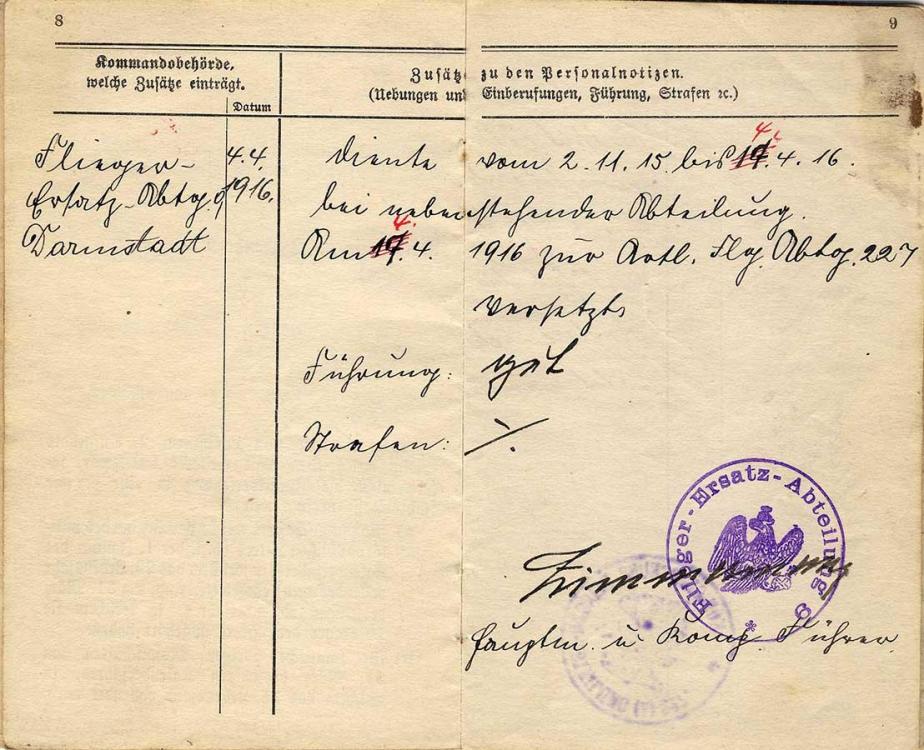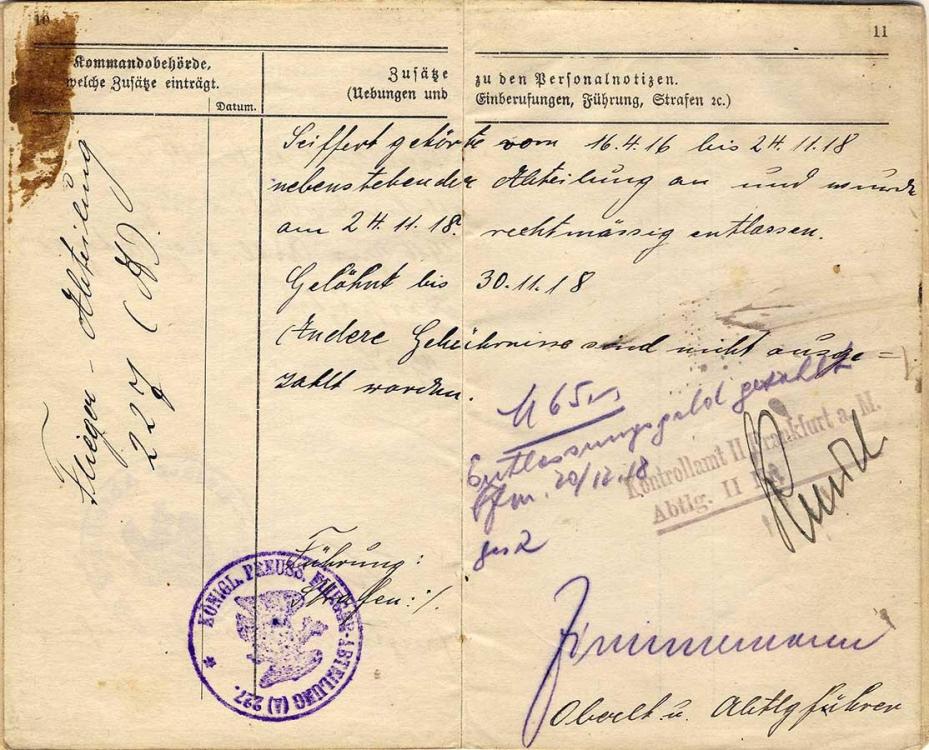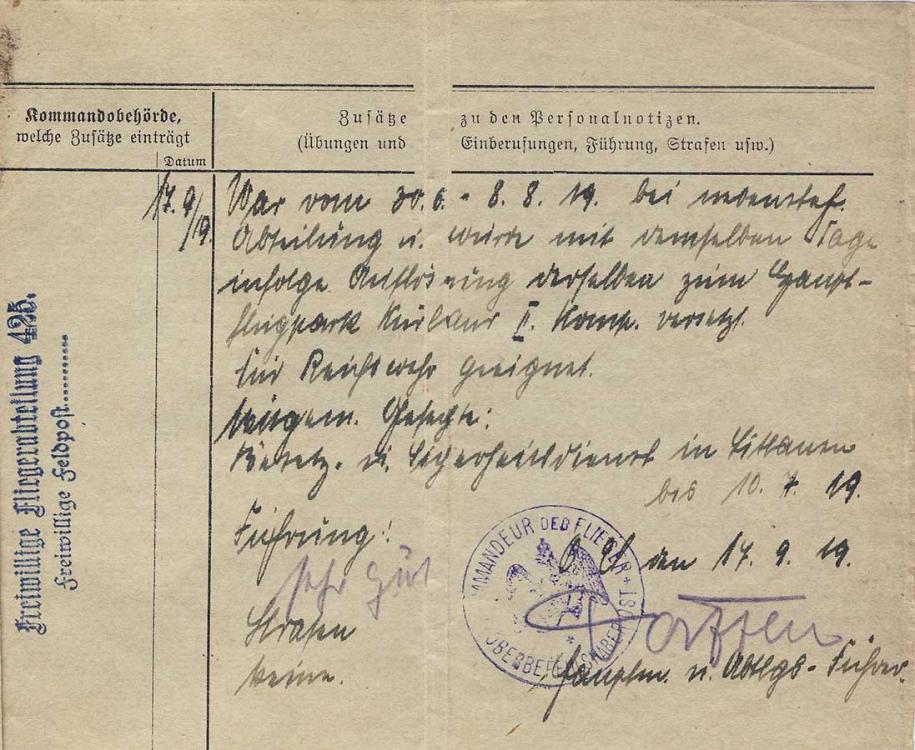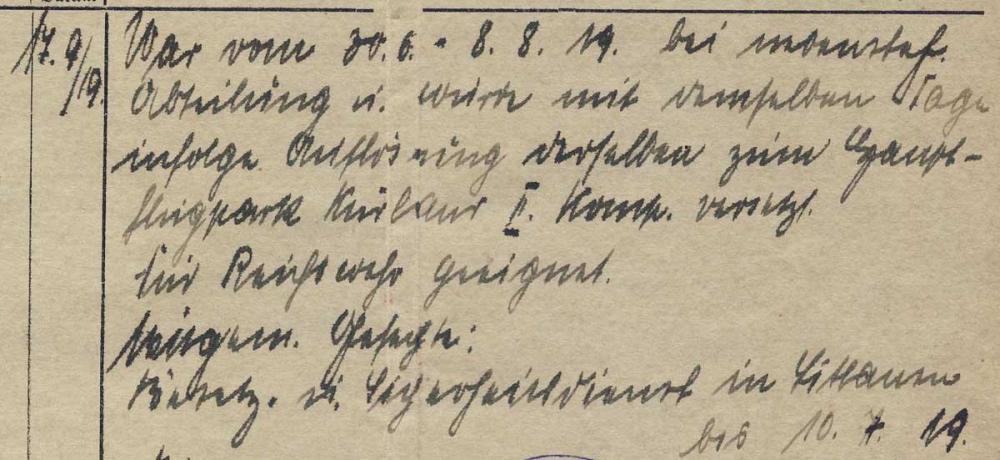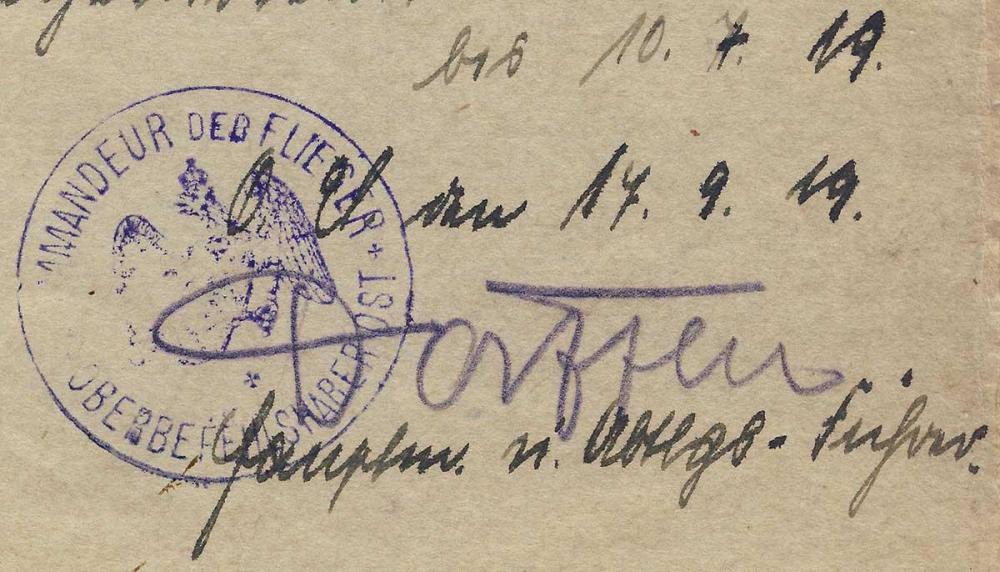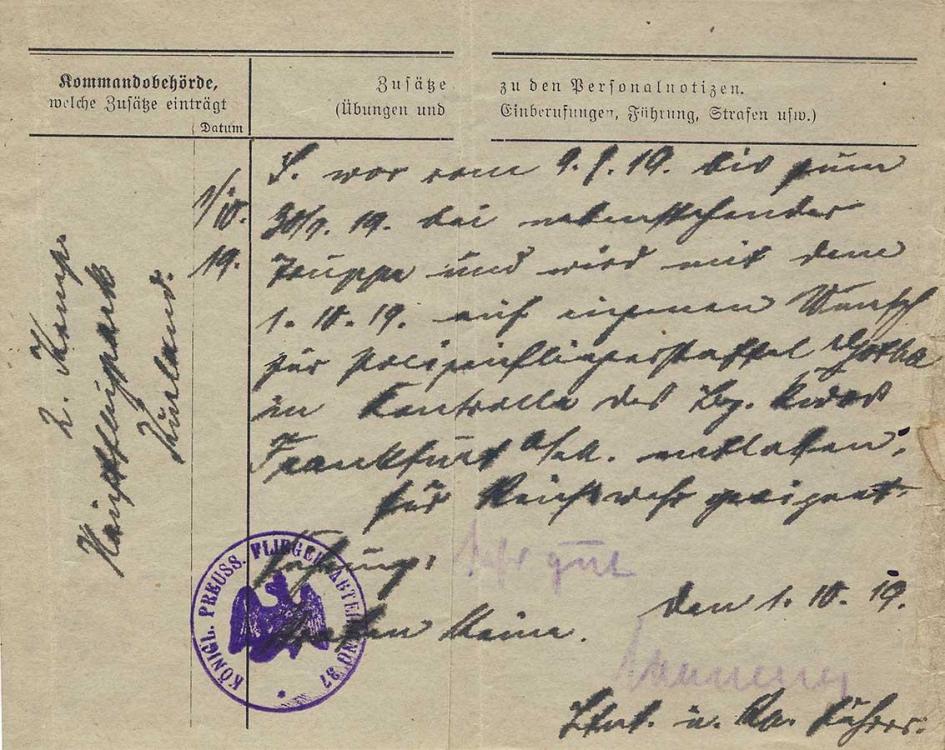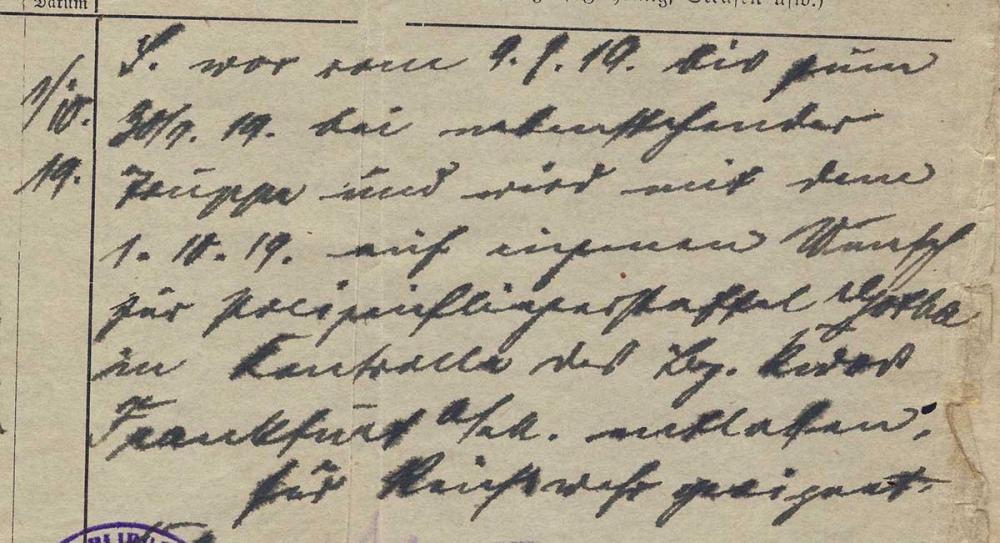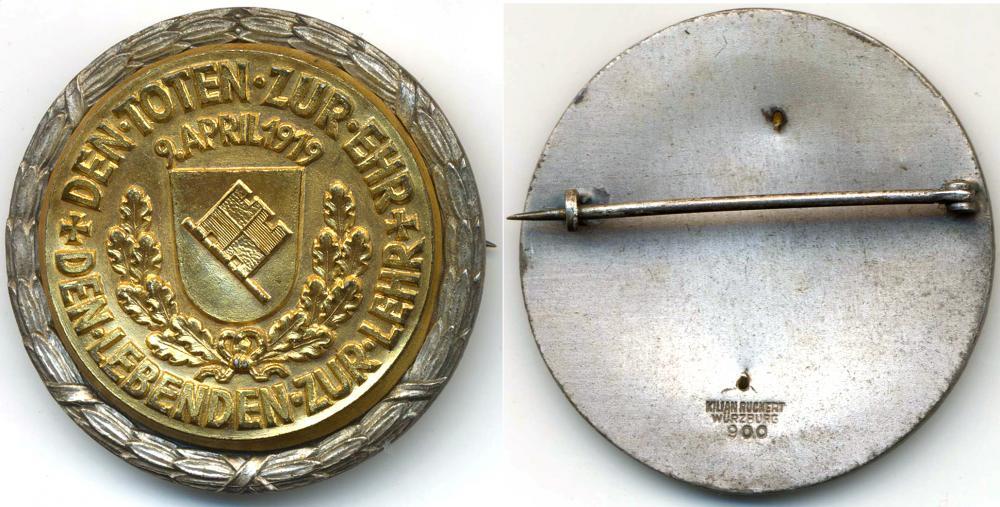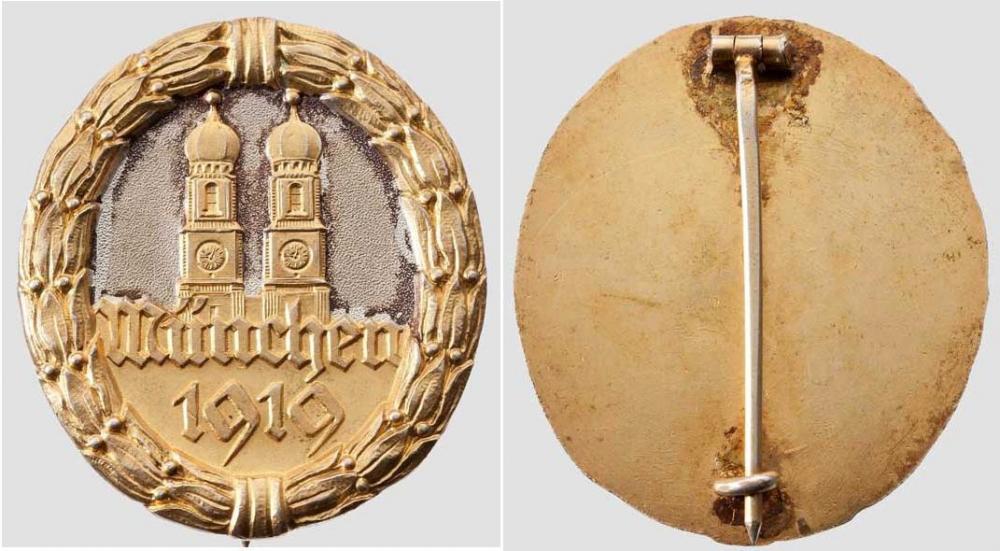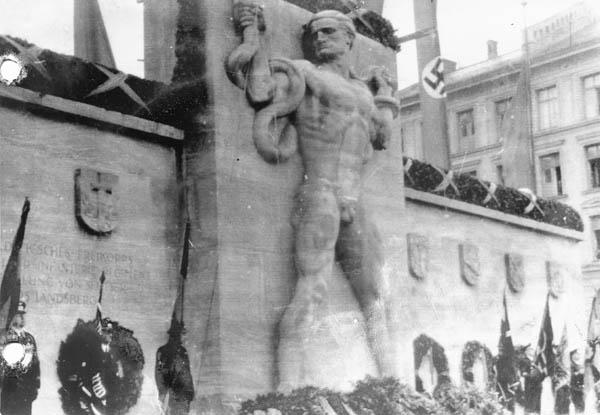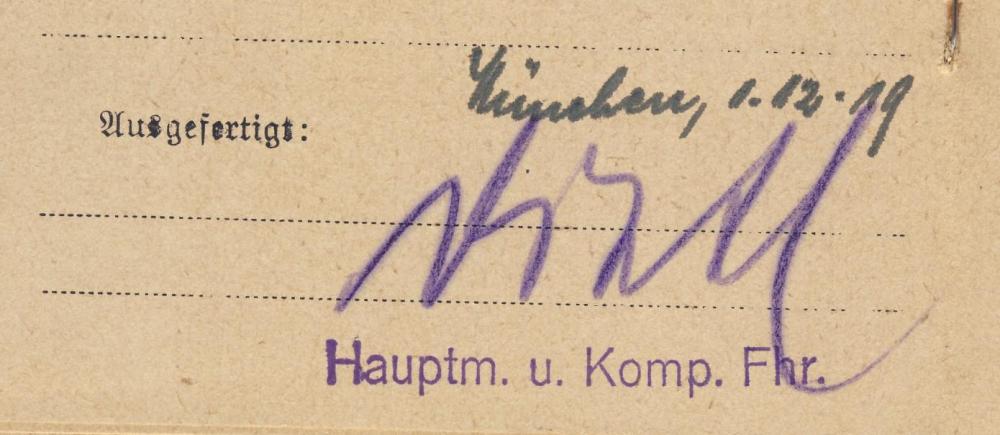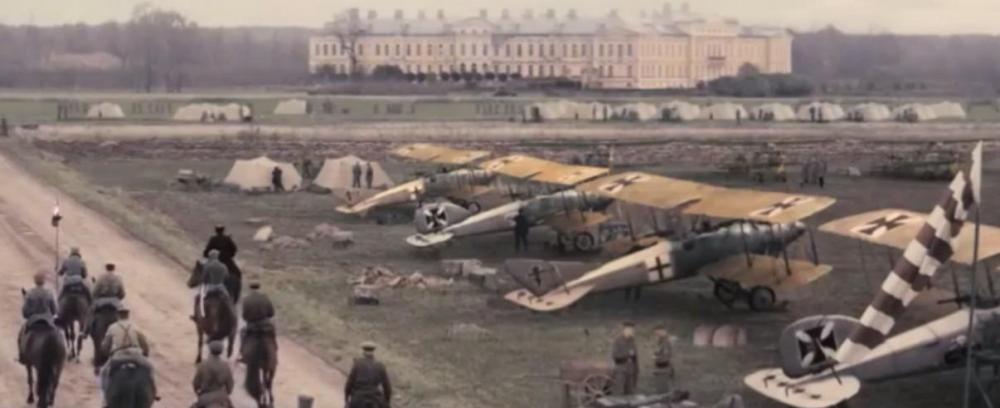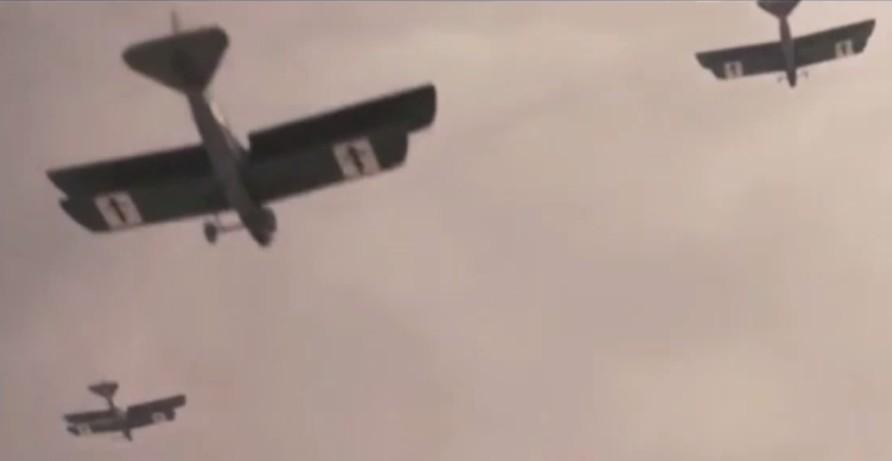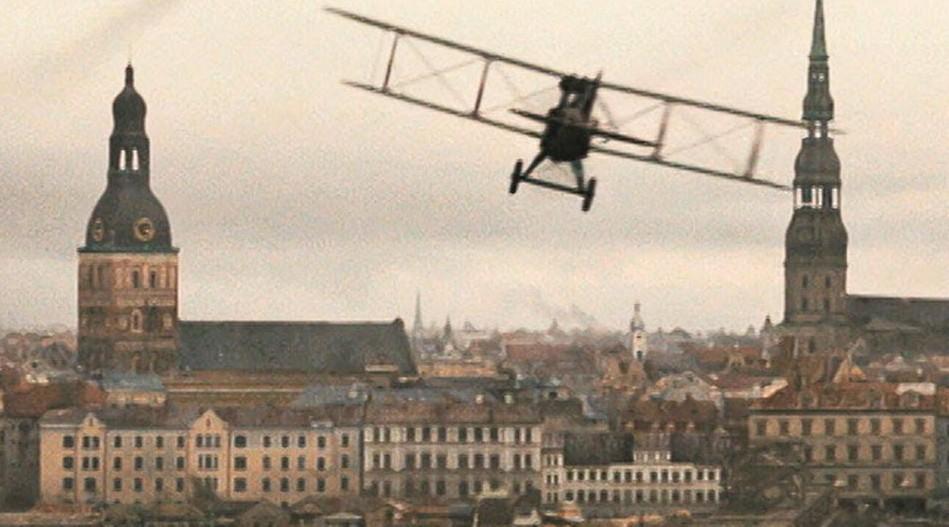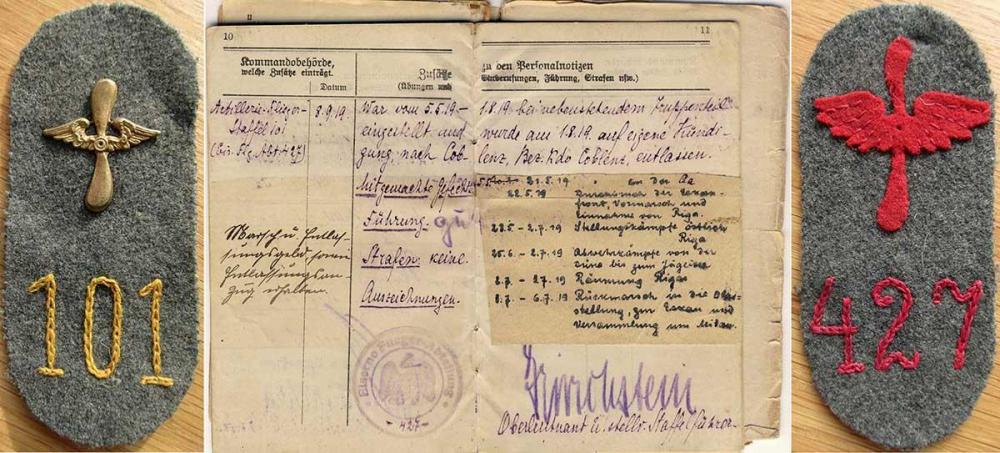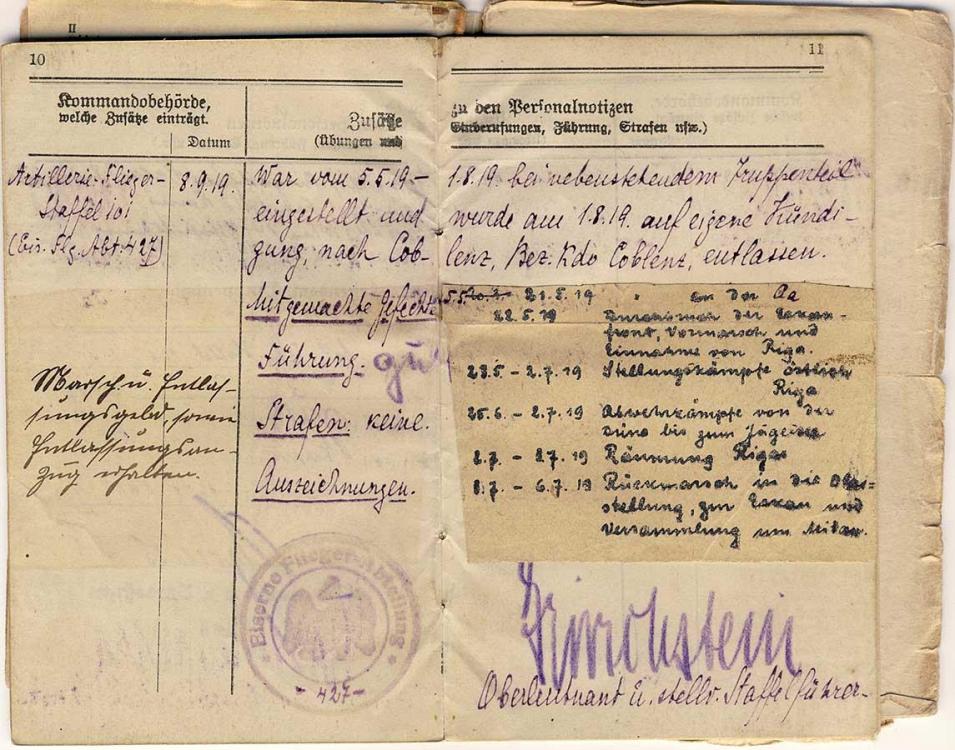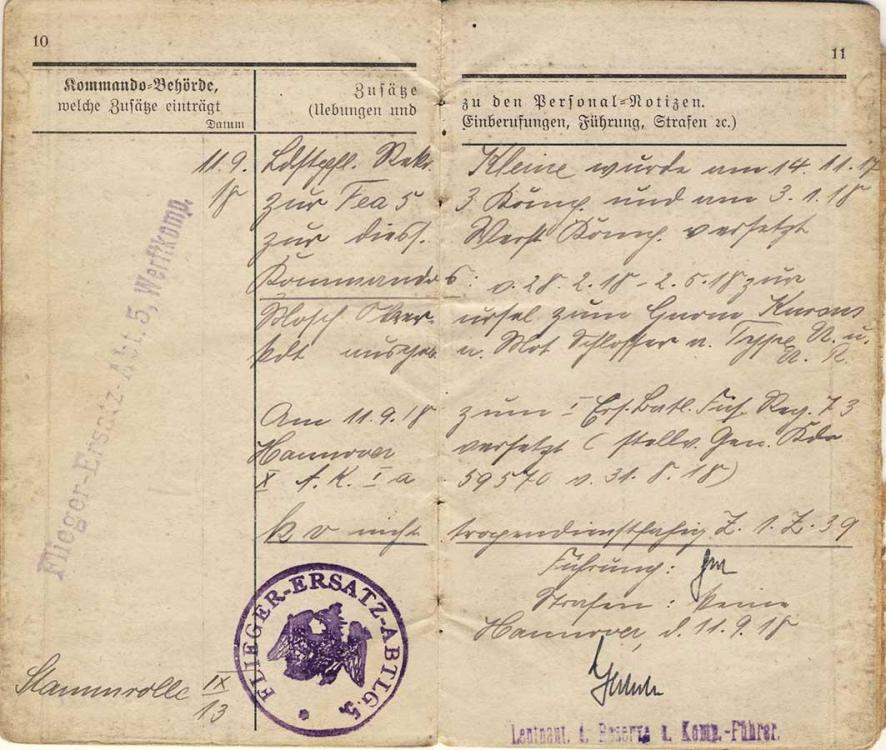
bolewts58
Active Contributor-
Posts
624 -
Joined
-
Last visited
-
Days Won
11
Content Type
Profiles
Forums
Blogs
Gallery
Events
Store
Everything posted by bolewts58
-
Here's another military pass for an Unteroffizier who served in aviation units during the war and went on to volunteer for Freiwillige Fliegerabteilung 425 which was part of Gotthard Sachsenberg's Geschwader Sachsenberg (officially known as Fliegerabteilung Ost with 50 officers and 650 other ranks) based at Wainoden airfield near Riga and fighting Bolsheviks in the Baltic Campaign. Here are the details: Unteroffizier Gotthold Adolf Wilhelm Seiffert 2/11/1915 - Flieger (airman) 1/2/1917 – Gefreiter (corporal) 19/6/1917 - Unteroffizier (sergeant) As an Unteroffizier, he would have been a ground crew section leader in charge of 8-14 men and 2-4 planes (3 ground crew to a plane). WWI (air service) 20/07/1915 - Fußartillerie-Regiment Generalfeldzeugmeister (Brandenburgishes) Nr. 3. 2/11/1915 - 04/04/1916 - Flieger Ersatz Abteilung 9 Darmstadt 16/04/1916 - 24/11/1918 - Fliegerabteilung 227 (A) Freikorps (air service) 30/06 -08/08/1919 - Freiwillige Fliegerabteilung 425. FFA425 was equipped with the Halberstadt CL IV. 09/08 - 30/09/1919 - Hauptflugpark Kurland (main airfield Kurland) – (stamped by Kommandeur der Flieger, Oberbefehlshaber Ost) 1/10/1919 – Polizeifliegerstaffel Gotha. Frankfurt – (stamped by königl. preuß. Fliegerabteilung 37). Seiffert asked to continue service in the police air unit. Likely left service in June 1920 when the police flying units were ordered dissolved. Participated Actions (Mitgemacht Gefechte) Besetzung und Sicherheitsdienst in Litauen (Occupation and security service in Lithuania) Signature Hauptmann Ernst Dörffler (WWII – Generalleutnant, Luftwaffe) Abteilung-Führer, FFA 425 (03/05 - 17/08/1919) Führer, Hauptflugpark Kurland (18/08 - 30/09/1919) Staffel-Fuhrer Polizeifliegerstaffel Gotha (01/10/1919 - 03/06/1920) Note: Ernst Dörffler's career in the Freikorps lines up perfectly with the entries in this Militärpass. Unteroffizier Gotthold Adolf Wilhelm Seiffert followed Dörffler into FFA 425, Hauptflugpark Kurland and finally Polizeifliegerstaffel Gotha on Oct. 1, 1919, which Dörffler commanded after FFA425 was dissolved at the end of Sept. 1919. Only, the police were allowed to maintain flying units until sometime in June 1920. Having a reference to continued service in a police air unit is quite scarce. Interestly, Dörffler was an observer and Seiffert a Flieger (airman) in Flieger Ersatz Abteilung 9 at the same time in 1916. Perhaps this is why Seiffert later volunteered to serve in FFA425 after Dörffler became its commander and followed him into the Polizeifliegerstaffel Gotha.
-
A small grouping.
bolewts58 replied to CRBeery's topic in Germany: Weimar Republic & Deutsche Freikorps
Possibly a Randow Cross. But, my guess is that the black Maltese Cross is the Avaloff Cross of the Russian West Army given that there is also a German styled Russian Order of St. George IV cl. and a Baltic Cross. This is a common grouping for Freikorps in the Baltic who stayed on to serve with Prince Bermondt-Avaloff. This chain might be Godet as the Order of St. George IV is in the style made by Godet which had grained arms and was modeled after the Prussian Red Eagle Order IV cl. -
Freikorps pin "Z" ?
bolewts58 replied to benten.'s topic in Germany: Weimar Republic & Deutsche Freikorps
Definitely not Freikorps. -
NSKK membership badge in gold
bolewts58 replied to rottweiller67's topic in Germany: Weimar Republic & Deutsche Freikorps
It is the same one. Also, why post it in the Weimar/Freikorps forum where it clearly does not belong? Is it because posting it in the TR forums will illicit the same strongly negative response and criticism the piece (and the poster) received on WRF? It's obvious looking at it, that it's cast and not of the quality one would expect from a German jeweler. -
I agree with your comment about the petition and think it's an insult to the cast and crew to have the audacity to ask for a redo. I went on the petition website and laid into the guy who started it and the people signing it, most of whom seem to be from that entitled, hyper-sensitive,self-centered generation, the millennials, a generation of privilege that has been over-parented and over-indulged. Anyway, enough of that. I thought all in all the show was amazing. I'm no expert on the War of the Roses, but the starting point for the inspiration is all the houses that either aligned with the Lancasters (Lannisters) or with the Yorks (Starks). That was supposedly George R.R. Martin's jumpining off point. Westeros is the UK and Essos is Europe and Asia as I understand it. The Wall is Hadrian's Wall and the land beyond the wall is Scotland and the wildlings are the Picts or the Vikings. The Dothraki are the Mongols and The Unsullied are the Janissaries. It would be interesting to try to draw lines between historical events and peoples and GOT.
-
And Now For Something Insanely Rare
bolewts58 replied to a topic in Germany: Weimar Republic & Deutsche Freikorps
Rich was basically right but got some details wrong when he introduced this thread. For one thing, this Freikorps was not formed to fight the reds in Würzburg. It was formed to fight the reds in Munich. Also, contrary to what Rich wrote in 2007, this was not the last Freikorps award. The last Freikorps award, which by the way former members of Freikorps Würzburg would have also been entitled to was called: Das Ehren- und Erinnerungszeichen der Befreier Münchens 1919 (Honor and Commemorative Badge for the Liberation of Munich, 1919) which was issued in 1938 and which is much, much rarer than the Freikorps Würzburg badge. Here's the full story of the Freikorps Würzburg badge. Commemorative Badge of the Freikorps Würzburg (Erinnerungsplakette des Freikorps Würzburg) Freikorps Würzburg was formed from the Bavarian Reserve Jäger Batallion 15, which returned to Germany from Georgia in April 1919 after a long, circuitous sea voyage by British merchant ship from the Black Sea to northern Germany and by train south to Bavaria. Bavarian Reserve Jäger Batallion 15 was formed in August 1918 in the Caucasus as the Kaukasisches Jäger-Regiment Nr. 1. It consisted of the bayerisches Reserve-Jäger-Bataillon and freshly trained released POWs who were formed into a Bahn-Schütz-Bataillon. On the 20th of September, 1918 they were renamed the bayerisches Reserve-Jäger-Bataillon Nr. 15 consisting of a staff and two battalions. The battalion was commanded by Major Martin Scheuring from the 8. B.I.R. who continued to command Freikorps Würzburg after its formation. Bavarian Reserve Jäger Regiment 15 literally arrived at the Würzburg train station on April 9, 1919 after their very long and arduous return home and immediately volunteered to form Freikorps Würzburg, got back on the train and headed to Munich to join other Freikorps already taking up positions outside the city. Freikorps Würzburg took part in the heavy fighting in Munich against the Munich Soviet Republic on May 2-3, 1919. After the defeat of the Munich Soviet, Freikorps Würzburg joined Detachement Probstmayer, Freikorps Aschaffenburg, Freikorps Bamberg, Freikorps Bayreuth, Eiserne Schar Berthold and other smaller Freikorps units to form Reichswehr-Brigade 23. The badge was given to former members of Freikorps Würzburg in 1934 on the 15th anniversary of its formation. The 2-piece badge is 900 silver with a silver gilt center medallion and marked on the reverse: KILIAN RUCKERT, WÜRZBURG, 900. A souvenir commemorative "tinnie" in bronze (shown in CRBeery's post) was given to everyone who attended the award ceremony. Here's mine. And here's the Liberation of Munich badge. Interestingly, this badge was issued after the 1935 edict banning the wear of all Freikorps awards except the Silesian Eagle, Baltic Cross and Carinthian Cross. Its award accompanied a dedication of a memorial to the liberation of Munich attended by leading Nazis (pictured below). -
Early Eduard Dietl signature as Hauptmann und Kompanie Führer in the 1. bayer. Reichswehr-Schützen-Regiment 41 (Freikorps Epp).
-
I'm resurrecting this thread to identify a couple of common fakes that were shown as genuine badges 10 years ago before these badges were identified as recent reproductions. These fake badges show the sail as "luffing" (flapping, i.e. with creases running through the sail) which would never happen with a ship sailing full bore with the wind. Ehrhardt, as an experienced sailor would never have approved a badge with such a technical error as this. So, obviously, whoever created the new die for this badge never sailed a sailboat. If compared to the genuine Ehrhardt badges and the gilt Wilhelmshaven badge, the mistake is obvious. There are other less obvious errors, which I don't want to identify, so as to not alert the fakers.
-
Firstly, it seems the original image has disappeared. But, I'll post a new one anyway because after 4 years I've finally reunited the original sleeve badges that were with the pass before the group was broken up and sold separately. It's just dumb luck that they turned up for sale and even better were mislabeled as WWI FFA sleeve badges, which allowed me to pick them up comparatively cheaply. So, here is the pass again reunited with the sleeve badges for Artillerie-Flieger-Staffel 101 and Eiserne-Flieger-Abteilung 427.
-
CD is Carl Dillenius, Pforzheim. Although this is not a typical Dillenius core.
-
Fantastic! Thank you very much to both spolei and speedytop for your help. This all makes sense as he was previously in Hannover Pionier Batl. 10 and afterwards was in an Eisenbahn-Bau Kompagnie in Panzerzug III, Freikorps Hulsen responsible for armor-plating the train and other construction duties.
-
Normally, I don't have a problem reading Kurrentschrift. But, I'm having trouble with some of the text, especially in the middle of the page because of the handwriting. It seems he was taking some kind of course which maybe had something to do with machining and perhaps types of airplane engines. But, that is a wild guess because there are too many gaps that I can't fill in. I may be way off. Is there anyone who can please give me a hand? thanks Brian
-
Freikorps or Tradition Skull?
bolewts58 replied to Uffz. Rohleder's topic in Germany: Weimar Republic & Deutsche Freikorps
It looks period to me. It's not 3rd Reich. It's possible it's an Iron Division cap badge or Freikorps Brüssow collar badge. But, it could also be Wehrwolf from the 1920s. Hard to say. -
Freikorps or Tradition Skull?
bolewts58 replied to Uffz. Rohleder's topic in Germany: Weimar Republic & Deutsche Freikorps
No way to definitively know if it's Freikorps or not because these were in use from before WWI through to the 30s by several military and paramilitary organizations. -
Agree. In many ways, it was more complex and layered with more than two sides and many competing ideologies and grievances. The Freikorps continued to exist in different forms, well past its use date because veterans and those that were too young to serve in WWI wanted to continue the camaraderie and esprit du corps of the trenches. That the Wehrwolf, Stahlhelmbund and SA grew so quickly was mostly to do with this desire for belonging rather than any hardcore political beliefs. This is why I take exception to the two English works on the subject, Robert G.L. Waite's Vanguard of Nazism and Nigel H. Jones' Hitler's Heralds because they put too much faulty emphasis on the direct line between the Freikorps and the Nazis. At best, I'd say that most members of the Freikorps drifted into the SA as a way to continue the Sturmsoldaten ethos rather than any zeal for the Nazi party's aims.

